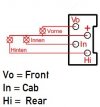Greg Elmassian
Guest
I agree, it is operator error.
But me taking that attitude to a friend who just destroyed something won't make him happy!
So, for me, for inexperienced people, and even some experienced ones, the "safer route" is the way I advise.
On this specific issue, I gotten in so many arguments with a newbie who is really intent on not adding a resistor....
But, for the people who have blown their LEDs, there is normally contrition, and a more careful attitude in the future.
All I can do is give my "best" and "bulletproof" advice... and withstand the guys saying "I have been running LEDs without resistors since there were dinosaurs".... for every guy that lucked out there are 10 guys with blown up LEDs.
Greg
But me taking that attitude to a friend who just destroyed something won't make him happy!
So, for me, for inexperienced people, and even some experienced ones, the "safer route" is the way I advise.
On this specific issue, I gotten in so many arguments with a newbie who is really intent on not adding a resistor....
But, for the people who have blown their LEDs, there is normally contrition, and a more careful attitude in the future.
All I can do is give my "best" and "bulletproof" advice... and withstand the guys saying "I have been running LEDs without resistors since there were dinosaurs".... for every guy that lucked out there are 10 guys with blown up LEDs.
Greg



